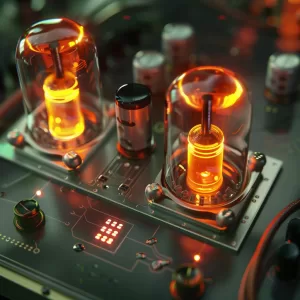
Unveiling the Optoisolator: A Bridge Between Electrical Worlds
March 11 2024 
Inquiry
Global electronic component supplier AMPHEO PTY LTD: Rich inventory for one-stop shopping. Inquire easily, and receive fast, customized solutions and quotes.
QUICK RFQ
ADD TO RFQ LIST
In this blog, we will delve into the fascinating realm of optoisolators, exploring their function, operational principles, applications, and so on.
What is an Optoisolator?

Who Invented Optoisolators?
There is no single inventor recognized for the precise invention of the optoisolator. The innovative work of multiple researchers in the 1950s and 1960s is acknowledged as the driving force behind the creation of this technology, nevertheless. Here are some key figures:- H. J. Reich: In 1956, Reich submitted a patent application for a gadget that sent signals using a photoconductive cell and a light source. The creation of optoisolators was made possible by this principle.
- Bell Labs: The 1960s saw major advances in optocoupler technology, including the introduction of LEDs as light sources, thanks to researchers at Bell Labs like H. K. Loar and F. D. Waldhauer.
- Siliconex: In the late 1960s, Siliconex introduced the IL-100, one of the first optoisolators to be sold commercially, establishing the usefulness of the technology.
Optoisolator Features
- High-Speed Optoisolators: Designed to handle signals in the megahertz (MHz) range, these optoisolators make use of quicker LEDs and photodetectors with better response times. They are intended for high-frequency data transmission.
- Linear Optoisolators: These specialized optoisolators use linear photodetectors for applications like sensor data isolation or audio signal isolation that call for accurate analog signal reproduction.
- Optocouplers with Integrated Circuits: For particular applications, certain optoisolators incorporate extra circuitry on the output side, such as Schmitt triggers or logic gates, to provide further functionality.
How Optoisolator Works?
Step 1: The Input Signal Arrives- Let's say you wish to maintain electrical isolation between a control circuit and another circuit that needs to receive a signal.
- The optoisolator's input receives a voltage from this control circuit.
- Depending on the input voltage strength:
- A greater voltage will result in a higher current passing through the light-emitting diode (LED) of the optoisolator.
- A lower voltage will cause the LED's current to flow through it less.
- Remember that LEDs are unique in that they emit light when current passes through them in a forward manner (positive on the anode, negative on the cathode). Thus, the electrical input signal is effectively transformed into a light signal by the LED.
- The isolation barrier is the primary component of an optoisolator. A light-transmitting substance, such as plastic or epoxy, is used to create this barrier. It fully blocks any electrical current while allowing the light from the LED to flow through. The electrical isolation between the circuits is created as a result.
- Imagine it as a one-way light bridge, where information can pass through but power cannot.
- A light detector is positioned on the optoisolator's receiving side. Usually, a phototransistor or photodiode is used as this detector.
- When this detector is illuminated by the LED light:
- Phototransistor: By permitting a higher current to pass through it, light functions as a switch that is managed by the LED on the input side.
- Photodiode: When exposed to light, the photodiode's current flow increases, turning the light signal it receives into a faint electrical current.
- On the opposite side of the optoisolator, an output signal is produced by the incoming light's alteration of the detector's electrical characteristics.
- Though it is now electrically separated, the original input signal is reflected in this output signal. Note that power conversion inefficiencies in the optoisolator may cause the output signal to be weaker than the input.
Video related to Optoisolators
Advantages of Optoisolators
- Galvanic Isolation: The capacity of optoisolators to create electrical isolation between circuits protects delicate components from noise interference, ground loops, and spikes in voltage. This is the main advantage of optoisolators.
- Noise Reduction: Optoisolators efficiently reduce noise coupling between circuits by erecting a physical barrier between the input and output sides, guaranteeing cleaner signal transmission.
- Signal Integrity: By reducing distortion and crosstalk that might happen in non-isolated circuits, optoisolators aid in maintaining signal integrity.
- Safety Improvement: By separating control circuitry from potentially dangerous situations, optoisolators increase safety in applications involving high voltages or medical equipment.
Disadvantages of Optoisolators
- Forward Current: The highest input current that can be used is determined by the LED's forward current rating. Overdoing it may cause harm to the LED.
- Response Time: The limited response time of optoisolators may make them unsuitable for high-frequency applications. Considering the requirements of your signal, select optoisolators with suitable reaction times.
- Cost: Optoisolators are often more expensive components when compared to basic resistors or capacitors. However, the advantages of solitude frequently exceed the drawbacks.
Where are Optoisolators Used?
Optoisolators are used in a variety of electronic systems because of their special capacity to offer electrical isolation while promoting signal transfer. Here are some prominent examples:- Power Supply Isolation: Optoisolators in the power supply can isolate the high-voltage AC mains from the low-voltage control circuits, improving safety and avoiding ground loop problems.
- Data Acquisition Systems: Optoisolators shield delicate data acquisition systems from electrical noise and possible harm when they interface with high-voltage equipment or noisy industrial settings.
- Medical Equipment: Optoisolators minimize unintentional current leakage by isolating the control circuitry from the patient interface in medical devices such as pacemakers and defibrillators. This ensures patient safety.
- Logic Level Shifting: By altering the signal format without compromising isolation, optoisolators can be utilized to bridge circuits with disparate logic levels (such as TTL and CMOS).
- Gate Drivers: Optoisolators segregate the control circuit from the high-current driver stage in high-power applications like motor drives, shielding the control circuitry from momentary voltage spikes.
Future of Optoisolators
The future of optoisolators appears promising as advancements in materials science and device fabrication continue. Here are some potential areas of development:- Higher Speed and Bandwidth: To meet the needs of high-speed communication systems, ongoing research attempts to create optoisolators with wider bandwidths and faster response times.
- Reduced Size and Cost: As a result of technological advancements, smaller optoisolators may become more accessible and easier to integrate into a wider range of applications due to their lower production costs.
- Novel Materials: Research into new materials for photodetectors and light sources may improve performance and open up new possibilities for optoisolators.
Conclusion
In the field of electrical isolation, optoisolators are essential because they protect delicate electronics, reduce noise interference, and guarantee error-free signal transmission. Optoisolators can be used to build durable and dependable electronic systems if you are aware of their uses, functioning principles, and factors to take into account. Optoisolators have the potential to have an even bigger impact on how electronics are developed in the future as technology advances.Related Articles
- ·Stratix 10 VS Stratix V: Which FPGA is Right for Your Next Project?
- ·Intel Xeon Platinum 8454H vs AMD EPYC: Which Reigns Supreme?
- ·A Deep Dive into the AMD EPYC 4564P Processor
- ·MSP430F5438A vs MSP430F5529: A Detailed Analysis of Their Capabilities
- ·Comparing MSP430F6659 and MSP430F5419A: Which One is Right for Your Project?
- ·Exploring the Features of MSP430F5529 and MSP430F5638 Microcontrollers
- ·Demystifying 20 Microcontroller Projects for Beginners
- ·Unveiling the Ultimate Guide to Microcontroller Programming
- ·4680 Battery: Unveiling the Power Potential of the Next-Gen Cell
- ·Exploring the Case Studies on Arduino Applications
Populer Posts
ADSP-21366YSWZ-2AA
Analog Devices Inc.
SAF7730HV/N331D,51
NXP Semiconductors
TMS320BC53SPZ57
Texas Instruments
SAF775DEL/N208/K1K
NXP Semiconductors
SAF775CHN/N208WCMP
NXP Semiconductors
ADSP-2183BST-115
Analog Devices Inc.
TMS320C28341ZHHT
Texas Instruments
Z8937320FSG
Zilog
SAF7730HV/N231D,55
NXP Semiconductors
TMS320DM641AZDK6
Texas Instruments
SAF7730HV/N336D,51
NXP Semiconductors
D172A4PJ92
Texas Instruments
